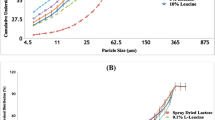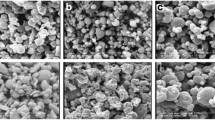Abstract
Purpose
To study the effect of the size of the surface-coated polycaprolactone (PCL) microparticle carriers on the aerosolization and dispersion of Salbutamol Sulfate (SS) from Dry Powder Inhaler (DPI) formulations.
Methods
The microparticles were fabricated using an emulsion technique in four different sizes (25, 48, 104 and 150 μm) and later coated with Magnesium stearate (MgSt) and leucine. They were characterized by laser diffraction and SEM. The Fine Particle Fraction (FPF) of SS from powder mixtures was determined by a Twin Stage Impinger (TSI).
Results
As the carrier size increased from 25 μm to 150 μm, the FPF of the SS delivered by the coated PCL particles increased approximately four fold. A linear relationship was found between the FPF and Volume mean Diameter (VMD) of the particles over this range.
Conclusions
The dispersion behaviour of SS from PCL carriers was dependent on the inherent size of the carriers and the increased FPF of SS with increased carrier size probably reflects the higher mechanical forces produced due to the carrier-carrier collisions or collisions between the carrier particles and the internal walls of the inhaler during aerosolization.









Similar content being viewed by others
Abbreviations
- d:
-
diameter
- DCM:
-
dichloromethane
- DPI:
-
dry powder inhaler
- ED:
-
emitted dose
- FPF:
-
fine particle fraction
- HPLC:
-
high performance liquid chromatography
- MgSt:
-
magnesium stearate
- MW :
-
molecular weight
- N:
-
particle number
- PCL:
-
polycaprolactone
- PVA:
-
polyvinyl alcohol
- RD:
-
recovered dose
- S1:
-
stage one
- S2:
-
stage two
- SEM:
-
scanning electron microscope
- SS:
-
salbutamol sulfate
- SX:
-
salmeterol xinafoate
- TSI:
-
twin stage impinger
- UV:
-
ultraviolet
- VMD:
-
volume median diameter
References
Hickey AJ, Concessio NM. Descriptors of irregular particle morphology and powder properties. Adv Drug Delivery Rev. 1997;26(1):29–40.
Young PM, Cocconi D, Colombo P, Bettini R, Price R, Steele DF, et al. Characterization of a surface modified dry powder inhalation carrier prepared by “particle smoothing”. J Pharm Pharmacol. 2002;54:1339–44.
Islam N, Stewart P, Larson I, Hartley P. Surface roughness contribution to the adhesion force distribution of salmeterol xinafoate on lactose carriers by atomic force microscopy. J Pharm Sci. 2005;94(7):1500–11.
Begat P, Price R, Harris H, Morton D, Staniforth J. The influence of force control agents on the cohesive-adhesive balance in dry powder inhaler formulations. KONA. 2005;23:109–21.
French DL, Edwards DA, Niven RW. The influence of formulation on emission, deaggregation and deposition of dry powders for inhalation. J Aerosol Sci. 1996;27(5):769–83.
Steckel H, Muller BW. In vitro evaluation of dry powder inhalers II: influence of carrier particle size and concentration on in vitro deposition. Int J Pharm. 1997;154(1):31–7.
Zeng XM, Martin GP, Marriott C, Pritchard J. The influence of carrier morphology on drug delivery by dry powder inhalers. Int J Pharm. 2000;200(1):93–106.
Karhu M, Kuikka J, Kauppinen T, Bergström K, Vidgren M. Pulmonary deposition of lactose carriers used in inhalation powders. Int J Pharm. 2000;196(1):95–103.
Kawashima Y, Serigano T, Hino T, Yamamoto H, Takeuchi H. Effect of surface morphology of carrier lactose on dry powder inhalation property of pranlukast hydrate. Int J Pharm. 1998;172(1–2):179–88.
Ganderton D. The generation of respirable clouds from coarse powder aggregates. J Biopharm Sci. 1992;3:101–5.
Lucas P, Anderson K, Potter UJ, Staniforth JN. Enhancement of small particle size dry powder aerosol formulations using an ultra low density additive. Pharm Res. 1999;16(10):1643–7.
Lucas P, Anderson K, Staniforth JN. Protein deposition from dry powder inhalers: fine particle multiplets as performance modifiers. Pharm Res. 1998;15(4):562–9.
Staniforth JN. Performance-modifying influences in dry powder inhalation systems. Aerosol Sci Technol. 1995;22(4):346–53.
Tee SK, Marriott C, Zeng XM, Martin GP. The use of different sugars as fine and coarse carriers for aerosolised salbutamol sulphate. Int J Pharm. 2000;208(1–2):111–23.
Byron P, Jashnani R, Germain S. Efficiency of aerosolization from dry powder blends of terbutaline sulfate and lactose NF with different particle size distribution. Pharm Res. 1990;7:S81.
Hamishehkar H, Emami J, Najafabadi AR, Gilani K, Minaiyan M, Mahdavi H, et al. Influence of carrier particle size, carrier ratio and addition of fine ternary particles on the dry powder inhalation performance of insulin-loaded PLGA microcapsules. Powder Technol. 2010;201(3):289–95.
Hassan MS, Lau R. Inhalation performance of pollen-shape carrier in dry powder formulation: effect of size and surface morphology. Int J Pharm. 2011;413(1–2):93–102.
Islam N, Stewart P, Larson I, Hartley P. Effect of carrier size on the dispersion of salmeterol xinafoate from interactive mixtures. J Pharm Sci. 2004;93(4):1030–8.
Islam N, Stewart P, Larson I, Hartley P. Lactose surface modification by decantation: are drug-fine lactose ratios the key to better dispersion of salmeterol xinafoate from lactose-interactive mixtures? Pharm Res. 2004;21(3):492–9.
Louey MD, Razia S, Stewart PJ. Influence of physico-chemical carrier properties on the in vitro aerosol deposition from interactive mixtures. Int J Pharm. 2003;252(1–2):87–98.
Ooi J, Traini D, Hoe S, Wong W, Young PM. Does carrier size matter? A fundamental study of drug aerosolisation from carrier based dry powder inhalation systems. Int J Pharm. 2011;413(1–2):1–9.
Podczeck F. The relationship between physical properties of lactose monohydrate and the aerodynamic behaviour of adhered drug particles. Int J Pharm. 1998;160(1):119–30.
Srichana T, Martin GP, Marriott C. On the relationship between drug and carrier deposition from dry powder inhalers in vitro. Int J Pharm. 1998;167(1–2):13–23.
Bell JH, Hartley PS, Cox JSG. Dry powder aerosols I: a new powder inhalation device. J Pharm Sci. 1971;60(10):1559–64.
Gilani K, Darbi M, Barghi M, Rafiee-Tehrani M. Influence of formulation variables and inhalation device on the deposition profiles of cromolyn sodium dry powder aerosols. Daru. 2004;12(3):123–30.
Kassem NM, Ho KKL, Ganderton D. The effect of air flow and carrier size on the characteristics of an inspirable cloud. J Pharm Pharmacol. 1989;41:14P.
Cline D, Dalby R. Predicting the quality of powders for inhalation from surface energy and area. Pharm Res. 2002;19(9):1274–7.
de Boer AH, Hagedoorn P, Gjaltema D, Goede J, Kussendrager KD, Frijlink HW. Air classifier technology (ACT) in dry powder inhalation Part 2. The effect of lactose carrier surface properties on the drug-to-carrier interaction in adhesive mixtures for inhalation. Int J Pharm. 2003;260(2):201–16.
Donovan MJ, Smyth HDC. Influence of size and surface roughness of large lactose carrier particles in dry powder inhaler formulations. Int J Pharm. 2010;402(1–2):1–9.
Byron P, Jashnani R, Germain S. Efficiency of aerosolization from dry powder blends of terbutaline sulfate and lactose NF with different particle size distribution. Pharm Res. 1980;7:S81.
Tuli RA, Dargaville TR, George GA, Islam N. Polycaprolactone microspheres as carriers for dry powder inhalers: Effect of surface coating on aerosolization of salbutamol sulfate. J Pharm Sci. 2012;101(2):733–45.
Wang S, Guo S. Disodium norcantharidate-loaded poly(ε-caprolactone) microspheres: II. Modification of morphology and release behavior. Int J Pharm. 2008;353(1–2):15–20.
Alway B, Sangchantra R, Stewart PJ. Modelling the dissolution of diazepam in lactose interactive mixtures. Int J Pharm. 1996;130(2):213–24.
de Boer AH, Hagedoorn P, Gjaltema D, Goede J, Frijlink HW. Air classifier technology (ACT) in dry powder inhalation: Part 1. Introduction of a novel force distribution concept (FDC) explaining the performance of a basic air classifier on adhesive mixtures. Int J Pharm. 2003;260(2):187–200.
Voss A, Finlay WH. Deagglomeration of dry powder pharmaceutical aerosols. Int J Pharm. 2002;248(1–2):39–50.
Coates M, Chan H-K, Fletcher D, Chiou H. Influence of mouthpiece geometry on the aerosol delivery performance of a dry powder inhaler. Pharm Res. 2007;24(8):1450–6.
Coates MS, Fletcher DF, Chan H-K, Raper JA. Effect of design on the performance of a dry powder inhaler using computational fluid dynamics. Part 1: grid structure and mouthpiece length. J Pharm Sci. 2004;93(11):2863–76.
Chew NYK, Chan H-K, Bagster DF, Mukhraiya J. Characterization of pharmaceutical powder inhalers: estimation of energy input for powder dispersion and effect of capsule device configuration. J Aerosol Sci. 2002;33(7):999–1008.
Concessio NM, VanOort MM, Knowles MR, Hickey AJ. Pharmaceutical dry powder aerosols: correlation of powder properties with dose delivery and implications for pharmacodynamic effect. Pharm Res. 1999;16(6):828–34.
Shur J, Harris H, Jones M, Kaerger J, Price R. The role of fines in the modification of the fluidization and dispersion mechanism within dry powder inhaler formulations. Pharm Res. 2008;25(7):1631–40.
Traini D, Young PM, Thielmann F, Acharya M. The influence of lactose pseudopolymorphic form on salbutamol sulfate-lactose interactions in DPI formulations. Drug Dev Ind Pharm. 2008;34(9):992–1001.
Hickey AJ, Mansour HM, Telko MJ, Xu Z, Smyth HDC, Mulder T, et al. Physical characterization of component particles included in dry powder inhalers. II. Dynamic characteristics. J Pharm Sci. 2007;96(5):1302–19.
Ibrahim TH, Burk TR, Etzler FM, Neuman RD. Direct adhesion measurements of pharmaceutical particles to gelatin capsule surfaces. J Adhes Sci Technol. 2000;14(10):1225–42.
Linsenbühler M, Wirth K-E. An innovative dry powder coating process in non-polar liquids producing tailor-made micro-particles. Powder Technol. 2005;158(1–3):3–20.
Acknowledgments AND DISCLOSURES
This work has been financially supported through a PhD studentship and Rinku Tuli would like to acknowledge the scholarship support provided by the Faculty of Science and Technology, Queensland University of Technology.
Author information
Authors and Affiliations
Corresponding author
Rights and permissions
About this article
Cite this article
Tuli, R.A., George, G.A., Dargaville, T.R. et al. Studies on the Effect of the Size of Polycaprolactone Microspheres for the Dispersion of Salbutamol Sulfate from Dry Powder Inhaler Formulations. Pharm Res 29, 2445–2455 (2012). https://doi.org/10.1007/s11095-012-0772-y
Received:
Accepted:
Published:
Issue Date:
DOI: https://doi.org/10.1007/s11095-012-0772-y




